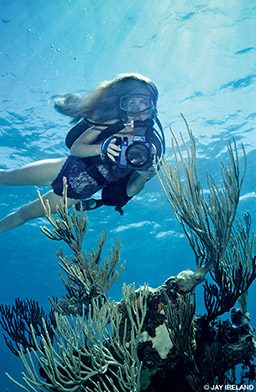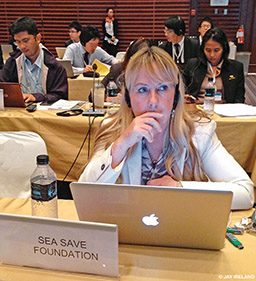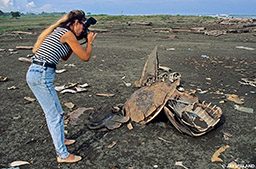Hometown: Croydon, Pa.
Years Diving: 32
Favorite Dive Destination: Cocos Island, Costa Rica
Why I’m a DAN Member: I can focus on my work knowing that DAN experts are available at any time and that I have access to premier evacuation coverage and medical treatment.
Georgienne Bradley, founder/director of Sea Save Foundation (seasave.org) and a producer at Bradley Ireland Productions, is an enthusiastic scientist, writer and activist who has spearheaded conservation efforts for most of her life.

Among Bradley’s many accomplishments are being the Latin American Representative for the Cousteau Society, the cochair/cofounder of the American Society of Media Photographers underwater specialty group, an inductee in the Women Divers Hall of Fame, an SSI Platinum Pro Award winner and the founder of Earth Images and Bradley Ireland Productions. She has written three books, hundreds of magazine articles and multiple scientific papers and has produced work for Paramount, Disney, National Geographic and others. Her first published documentation of shark finning was in 1989. One of Bradley’s most noteworthy achievements was having worked closely with the Costa Rican government for more than 26 years on projects protecting Cocos Island and its shark population, culminating in Cocos Island becoming a United Nations Educational, Scientific, and Cultural Organization (UNESCO) World Heritage Site.
How did a girl from Pennsylvania discover diving?
Both my parents and grandparents owned marinas, so I was on the water from a young age, moving the boats around. In high school, a friend of mine was a diver. I knew you weren’t supposed to dive if you didn’t have the certification, but I was a strong swimmer and young and stupid. In Monterey, Calif., I convinced my friend to rent some gear, and I walked off the pier and laid on my back in the water and watched a sea lion bark at me. I thought, “This is the coolest thing ever.” My friend then realized I’d never dived before, and I had to ‘fess up. She then told me the area we’d just seen was rubbish, but even so I had been thrilled by it.
What made you decide on a career in diving?
There’s a twofold answer to this. The first part I can summarize with a name: Jacques Cousteau. What Cousteau was doing was all new. I was a kid watching with my family, and he would use his camera to bring us along on his adventure.

Subconsciously, I think, I saw how you could inspire with imagery. It’s a very strong tool. At Sea Save the lengths to which we have to go to get people to take advocacy steps is crazy. People want to see the oceans protected but are not always willing to take time to engage, even in the smallest actions. Cousteau showed people the personalities of whales and the beauty of the oceans, and from there it was an easy sell to get people to say, “Let’s protect them.”
The second thing that moved me toward a career in diving was a project I spearheaded: the Costa Rica Marine Imaging Project (CRMIP). I recognized that there was a strong need for marine-related educational programs in Costa Rica; with some creative solutions, Jay Ireland, my partner at Bradley Ireland Productions, and I were able to execute several national educational programs with little funding. The projects included the creation of a series of national postage stamps and educational and PR campaigns that increased awareness and cultivated local stewardship. At CRMIP I worked closely with Costa Rica’s president, José María Figueres Olsen, and Cocos Island director, Joaquin Alvarado, documenting the national park and creating a visual presentation that helped gain Cocos Island a place in the list of UNESCO World Heritage Sites.
Cocos Island has had a special place in your heart since then — tell us more about Cocos.
Cocos is a remote island where time has stood still. When I first went there, it changed my life. After working in ocean conservation, I decided not to finish medical school and instead went in a different direction.
When we are talking about the oceans and protecting them, we can liken our passion for the ocean to passion for poetry and art — things that are important to the soul. We might have food — the sustenance we require to live — but we need things that fill our souls, that make us want to survive. From Robert Louis Stevenson to Michael Crichton, many writers and artists have gone to Cocos; I am just one of many that this place has changed.
I am always happy when I go back to a place and see that it hasn’t been harmed very much. But I go back to Cocos, and it’s better. Now we see whitetip sharks hunting, resident tiger sharks and orcas coming in consistently.

Speaking of sharks, Sea Save’s “Give ’em the Fin” campaign to stop shark finning is wrapping up after three years, and you’re focusing on something new. What’s next?
Next year one of our major campaigns will target Cocos Island. It is so remote, and that’s what has protected it. But as megafauna begin to diminish throughout the oceans, people are casting an eye on Cocos and similar places as the last spots to catch sharks.
We are planning a 2017 expedition to go there and reestablish our communication program. We will be speaking with leadership on the island. We only hear about Cocos when there is trouble, but our idea is to develop “The Voice of Cocos Island,” a program to educate people about what’s going on there.
Can the public get involved?
Yes! We still have a few spots on our Cocos Island liveaboard expedition (Feb. 15-25, 2017), with a portion of the payment funding conservation. We will have a submarine on board and a top-notch crew. There will be talks about the history of Cocos Island and why it’s a world heritage site and, of course, lots of diving. Visit SeaSave.org to see what it’s all about.
© Alert Diver — Q4 Fall 2016